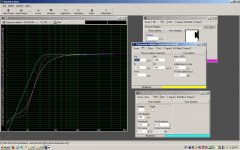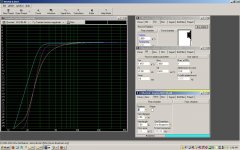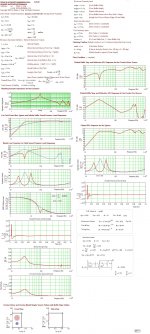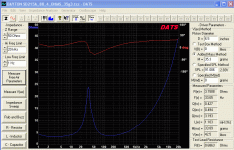I have been playing around with WinISD trying to create a small enclosure for the cheap Dayton Audio 8" subwoofer. I know that I am not going to have HT window shattering results with this setup but I wanted to do something cheap that functioned. My main sub is a Klipsch RW-10 this would be for like a .2 addition since I have a plate amp and I'm bored.
I like passive radiators due the fact of no port noise. I have modeled 2 different configurations and compared to an open port.
Blue Line - Ported 1.5cu ft 30Hz
Pink Line - 10" PR 2.0cu ft 32.5Hz
Yellow Line - 8" PR 1.0cu ft 30.5Hz
I am shooting for a very small enclosure with the best results. Can the passives compare to the ported?? Using 2 8" PR's I can get a better roll off but the compromise is a larger box volume. Current weights are 10g.
I like passive radiators due the fact of no port noise. I have modeled 2 different configurations and compared to an open port.
Blue Line - Ported 1.5cu ft 30Hz
Pink Line - 10" PR 2.0cu ft 32.5Hz
Yellow Line - 8" PR 1.0cu ft 30.5Hz
I am shooting for a very small enclosure with the best results. Can the passives compare to the ported?? Using 2 8" PR's I can get a better roll off but the compromise is a larger box volume. Current weights are 10g.
Attachments
Last edited:
WinISD says 2" port 5 inches long in 1.5cu ft. What am I missing? With the plate amp the lowpass is variable 120-40Hz. So the speaker will never see much more than that.
Here also is the TF showing the -3db points of each.
Here also is the TF showing the -3db points of each.
Attachments
Last edited:
When using WinISD use the 'Cone excursion' graph to set the power level, then go to the 'Rear port - Air velocity' graph to set up the port size so that the velocity is under 10m/s at full output. This is much more important with small port diameters than it is with large ports.
I recommend you get a program called Flare-it. It will show you what the maximum velocity a particular diameter can handle. Flare-it - Free Speaker Design Software
I recommend you get a program called Flare-it. It will show you what the maximum velocity a particular diameter can handle. Flare-it - Free Speaker Design Software
Thanks b!!! That confirms that I am using WinISD properly. I am going to build a ported and passive box and try them both out. Its not all about performance it is about how it sounds to the listener as well. This is becoming another neat little project that maybe I can match up with my class D chip amp if I ever finish that.
,,,That confirms that I am using WinISD properly. I am going to build a ported and passive box and try them both out. Its not all about performance it is about how it sounds to the listener as well...
Hi crazifunguy,
Yes you've done it right..If you build a 50L ported box you have the option to stuff the port until the enclosure turns into a closed one, that is f3 can be gradually decreased from ~50Hz to about 90Hz(Qtc=~0.6) to find out what sounds the best..
b
I like this 8" Dayton very much. Only limitation is maximum power output. As long as you don't intend to drive it at insane levels, it's fine.
My initial test was in a 25L Bass Reflex. Surprisingly good. It is now in a Bandpass box. Even better.
Below are the T/S that I measured with DATS. More information at Dayton SD215A-88 DVC.
Regards
Mike
My initial test was in a 25L Bass Reflex. Surprisingly good. It is now in a Bandpass box. Even better.
Below are the T/S that I measured with DATS. More information at Dayton SD215A-88 DVC.
Regards
Mike
Attachments
- Status
- This old topic is closed. If you want to reopen this topic, contact a moderator using the "Report Post" button.
- Home
- Loudspeakers
- Subwoofers
- Questions about design - DA SD215A-88



